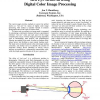Free Online Productivity Tools
i2Speak
i2Symbol
i2OCR
iTex2Img
iWeb2Print
iWeb2Shot
i2Type
iPdf2Split
iPdf2Merge
i2Bopomofo
i2Arabic
i2Style
i2Image
i2PDF
iLatex2Rtf
Sci2ools
PICS
2001
2001
Red Eye Removal using Digital Color Image Processing
The current paper provides methods to correct the artifact known as "red eye" by means of digital color image processing. This artifact is typically formed in amateur photographs taken with a built-in camera flash. To correct red eye artifacts, an image mask is computed by calculating a colorimetric distance between a prototypical reference "red eye" color and each pixel of the image containing the red eye. Various image processing algorithms such as thresholding, blob analysis, and morphological filtering, are applied to the mask, in order to eliminate noise, reduce errors, and facilitate a more natural looking result. The mask serves to identify pixels in the color image needing correction, and further serves to identify the amount of correction needed. Pixels identified as having red-eye artifacts are modified to a substantially monochrome color, while the bright specular reflection of the eye is preserved.
Color Image | Image Processing | PICS 2001 | Red Eye |
| Added | 31 Oct 2010 |
| Updated | 31 Oct 2010 |
| Type | Conference |
| Year | 2001 |
| Where | PICS |
| Authors | Jon Yngve Hardeberg |
Comments (0)

